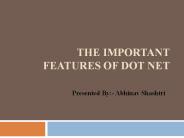'NET - PowerPoint PPT Presentation
1 / 27
Title:
'NET
Description:
Toolkit di Unit Testing ... Pratica comune nello unit testing avvalersi delle asserzioni, ossia della ... Studio 2005 includono un toolkit di unit testing: ... – PowerPoint PPT presentation
Number of Views:23
Avg rating:3.0/5.0
Title: 'NET
1
.NET Software Testing
- Andrea Saltarello
- Software Architect Managed Designs S.r.l.
- http//blogs.ugidotnet.org/pape
2
Sponsor
3
Parliamo di
- Design/Test/Interaction patterns
- Unit Testing
- Mock Objects
- Visual Studio 2005
4
- If it aint tested, its broken
- (cit. Bruce Eckel)
5
Software Testing 101
- Possiamo dichiarare funzionante il nostro
software solo se siamo in grado di dimostrarlo - Il funzionamento si dimostra mediante appositi
test - Utilizzare un software non è considerabile una
pratica di test (AntiPattern TestByReleasing,
TestingByPokingAround, )
6
Tipologie di test
- Esistono differenti tipologie di test
- Programmer Test/Technology facing (definiti anche
unit test) - Customer Test/Business facing (definiti anche
acceptance test o functional test) - Stress/Load Test
- Usage Test
- Noi parleremo di Unit Testing
7
Unit Testing 101
- Lo Unit Testing è una tipologia di test
automatico, basata sulla possibilità di
sottoporre a test i singoli componenti di un
sistema per verificarne la capacità di soddisfare
i requisiti. - I suddetti test sono definiti unitari, e sono
programmi batch che utilizzano le nostre classi
inviando messaggi prefissati in modo da poter
verificare la risposta della classe stessa
8
(No Transcript)
9
Toolkit di Unit Testing
- Esistono (almeno) 2 affermati toolkit di unit
testing per .NET, entrambi ispirati alla suite
xUnit ideata da Kent Beck ed Erich Gamma - NUnit
- csUnit
- Noi usiamo NUnit
10
NUnit 101
- NUnit è composto da un assembly (contenente il
framework di unit testing) e da una applicazione
host in grado di eseguire i test e produrre un
report. Per realizzare i test - Creare una class library che conterrà i test
- Definire una classe, e implementare i test sotto
forma di metodi - Decorare i metodi di test con lattributo
TestAttribute - Decorare la classe che contiene i test con
lattributo TestFixture - Eseguire lassembly dei test mediante
lapplicazione host
11
Unit Testing - Asserzioni
- Pratica comune nello unit testing è avvalersi
delle asserzioni, ossia della capacità di
definire delle condizioni che verificano la
correttezza di funzionamento del codice in esame - NUnit permette di definire delle asserzioni
mediante la classe Assert - Se lasserzione non è soddisfatta, il test
fallisce
Test public void TestSum() int number
4 Assert.AreEqual(2, (int) Math.Round(number))
12
(No Transcript)
13
NUnit un assembly con gli Attributi
- La libreria contiene differenti attributi, tra i
quali - TestFixture
- Test
- SetUp
- TearDown
- ExpectedException
- Ignore
Test ExpectedException(typeof(ArgumentNullExcep
tion)) public void TestSum() int number
int.Parse(null)
14
Houston, abbiamo un problema!
- Il test unitario insiste su uno specifico
componente - Un componente interagisce con altri componenti,
eventualmente residenti su layer differenti - Il fallimento di un componente esterno può
provocare il fallimento di un test - Può essere conveniente isolare il componente
sottoposto a test
15
Isolare un componente
- Esistono alcuni pattern specifici, ispirati allo
Special Case - Stub/Shunt
- Fake Objects
- Mock Objects
- Diamo anche una occhiata ad Inversion of Control
(a.k.a. Dependency Injection)
16
Stub/Shunt
- The most simple implementation of an interface.
Tipically, one might implement every method call
by throwing a runtime exception.
17
Fake Object
- A class with methods that return a fixed value or
values that can either be hardcoded or set
programmatically
18
(No Transcript)
19
Mock Objects
- An object which, in addition to implementing the
interface (like a Stub/Shunt) and returning
meaningful values (like a Fake), allows for
verification that the correct calls were made
upon the object, perhaps in the correct order.
20
Creare Mock Object
- Esistono toolkit free appositi
- DotNetMock
- NMock
- Noi usiamo NMock
21
NMock
- La classe DynamicMock
- usa CodeDom e Reflection per creare dinamicamente
un Mock Object - Permette di istruire il Mock mediante metodi
quali SetupResult e ExpectAndReturn
DynamicMock mockGenerator new
DynamicMock(typeof(RealObjectType)) RealObjectTyp
e mockObject (RealObjectType)
mockGenerator.MockInstance
mockGenerator.SetupResult(MethodName, 42, new
Type) int result mockObject.MethodName()
22
(No Transcript)
23
Fake vs. Mock
- Secondo Ward Cunningham, dovremmo preferire un
Mock se - real object has non-deterministic behavior
- real object is difficult to set up
- real object has behavior that is hard to cause
(e.g., network error) (similar to 1) - real object is slow
- real object has (or is) a UI
- test needs to query the object, but the queries
are not available in the real object (e.g., "was
this callback called?") - real object acts "normal" most of the time, but
once a month (or even less often) it does
something "exceptional". We want UnitTests to
make sure the rest of the system does the
RightThing whether or not the object is acting
"normal" or "exceptional". (Is this the same as
2 ?) - real object does not yet exist
24
Ritorno al Futuro Visual Studio 2005
- I Team System di Visual Studio 2005 includono un
toolkit di unit testing - Strepitosamente simile a NUnit (Indovinello dove
lavora oggi James Newkirk, ex project leader di
NUnit? ?) - Dotato di funzionalità di code coverage
25
(No Transcript)
26
Riferimenti
- Tools
- NUnit http//www.nunit.org
- csUnit http//www.csunit.org
- NMock http//www.nmock.org
- DotNetMock http//dotnetmock.sourceforge.net
- TestDriven.NET http//www.testdriven.net
- Documentazione
- NUnit vs. Team System
- Mocks Aren't Stubs
- Mock Stub Shunt
- Mock Objects to the Rescue!
27
Links
- http//www.ugidotnet.org
- http//forum.ugidotnet.org
- http//mobile.ugidotnet.org































